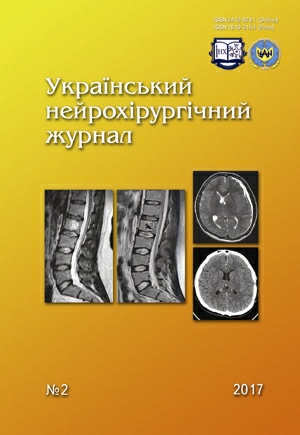Methods for prophylaxis and treatment of subcutaneous cerebrospinal fluid accumulation in the early postoperative period after surgery of skull base meningiomas
DOI:
https://doi.org/10.25305/unj.104499Keywords:
meningioma, skull base, subcutaneous accumulation of cerebrospinal fluid, pseudomeningoceleAbstract
The objective of the study was to investigate the causes of postoperative subcutaneous accumulation of cerebrospinal fluid (CSF), improvement of techniques of surgical wound sealing, and the development of a clear algorithm for therapeutic manipulation aimed at eliminating this complication.
Materials and methods. During the period from 2004 to 2016 at the Neurosurgery Department of Hospital 196 patients with skull base meningiomas were treated, of which 207 operations were performed.
Eighty-eight (44.6%) patients had anterior meningiomas, 73 patients had medium and 36 patients had posterior fossa meningiomas. The patients’ age ranged from 17 to 74 years (mean age 45 years). There were 107 (54.3%) males and 90 (45.7%) females.
In order to seal the dura mater for small defects pericranial flaps and aponeurosis fragments as well as muscle and fat tissue fragments and monocomponent medical cyanoacrylate glues as Sulfakrilat and Epiglue were used.
Result. We analyzed the data of 161 observations of postcranial fossa and medium fossa meningiomas. Subaponeurotic CSF accumulation in the early postoperative period was revealed in 32 (19.8%) patients. Thirty-two patients had anterior fossa pseudomeningocele eliminated spontaneously. The inclusion criterion was the presence of subcutaneous CSF accumulation since 2nd day by imaging and palpatory data. The paper analyzed the main causes of subaponeurotic CSF accumulation after surgery. Features of soft tissue flapping, craniotomy, resection and sealing of the dura, suturing the surgical wound were important for its prevention.
The paper determines the basic methods for medical and surgical correction of complications following as: a pressure bandage, percutaneous aspiration of cerebrospinal fluid syringe, the use of elastic bandages, hypodermic and lumbar drainage, wound revision and sealing.
Conclusion. 1. The main reasons for meningocele in the early postoperative period were increased pressure of cerebrospinal fluid and dura mater defect. 2. Even with careful suturing wounds using known methods for dura mater sealing, in the area of craniotomy subaponeurotic accumulation of fluid can occur, mostly in the frontal area due to the elasticity of soft tissue grafts and lack of muscle layer. 3. Pseudomeningocele in the early postoperative period requires all necessary surgical and medical methods for this complication early removing.
References
1. Hyndman OR, Gerber WF. Spinal extradural cysts, congenital and acquired; report of cases. J Neurosurg. 1946;3(6):474-86. [CrossRef] [PubMed]
2. Miller PR, Elder FW Jr. Meningeal pseudocysts (meningocele spurius) following laminectomy. Report of ten cases. J Bone Joint Surg Am. 1968;50(2):268-76. [PubMed]
3. Hawk MW, Kim KD. Review of spinal pseudomeningoceles and cerebrospinal fluid fistulas. Neurosurg Focus. 2000;9(1):e5. [CrossRef] [PubMed]
4. Couture D, Branch CL Jr. Spinal pseudomeningoceles and cerebrospinal fluid fistulas. Neurosurg Focus. 2003;15(6):E6. [PubMed]
5. Attia M, Umansky F, Paldor I, Dotan S, Shoshan Y, Spektor S. Giant anterior clinoidal meningiomas: surgical technique and outcomes. J Neurosurg. 2012;117(4):654-65. [CrossRef] [PubMed]
6. Behari S, Giri PJ, Shukla D, Jain VK, Banerji D. Surgical strategies for giant medial sphenoid wing meningiomas: a new scoring system for predicting extent of resection. Acta Neurochir (Wien). 2008;150(9):865-77. [CrossRef] [PubMed]
7. Nakamura M, Roser F, Jacobs C, Vorkapic P, Samii M. Medial sphenoid wing meningiomas: clinical outcome and recurrence rate. Neurosurgery. 2006;58(4):626-39. [CrossRef] [PubMed]
Downloads
Published
How to Cite
Issue
Section
License
Copyright (c) 2017 Andrii A. Oblyvach

This work is licensed under a Creative Commons Attribution 4.0 International License.
Ukrainian Neurosurgical Journal abides by the CREATIVE COMMONS copyright rights and permissions for open access journals.
Authors, who are published in this Journal, agree to the following conditions:
1. The authors reserve the right to authorship of the work and pass the first publication right of this work to the Journal under the terms of Creative Commons Attribution License, which allows others to freely distribute the published research with the obligatory reference to the authors of the original work and the first publication of the work in this Journal.
2. The authors have the right to conclude separate supplement agreements that relate to non-exclusive work distribution in the form of which it has been published by the Journal (for example, to upload the work to the online storage of the Journal or publish it as part of a monograph), provided that the reference to the first publication of the work in this Journal is included.









